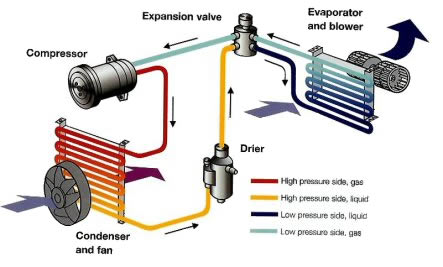Condenser
The Condenser works in the opposite way to the Evaporator. The refrigerant gives up its heat generated by the Compressor by passing cold air across its fins and tubes by ram air or by an extra fan. The end result of this change is that the refrigerant is now a high pressure liquid and is forced out to the Receiver Drier through the liquid line.
Filter Drier
Depending on the type of air conditioning system fitted, this item can be called a Receiver Drier or an Accumulator. (The Accumulator is fitted on the low pressure gas line of an air conditioning system between the Compressor and the Evaporator and is used in conjunction with an orifice tube). The Receiver Drier is fitted on the high pressure liquid line of an air conditioning system between the Condenser and Expansion Device. The Receiver Drier has two parts to it, the receiver and, of course, the drier. The receiver section holds the right amount of refrigerant required by the system to ensure correct operation and to supply a steady flow of liquid refrigerant to the Expansion Device. The drier section is responsible for removing moisture from the air conditioning system by means of a bag of desiccant, which absorbs small quantities of moisture.

